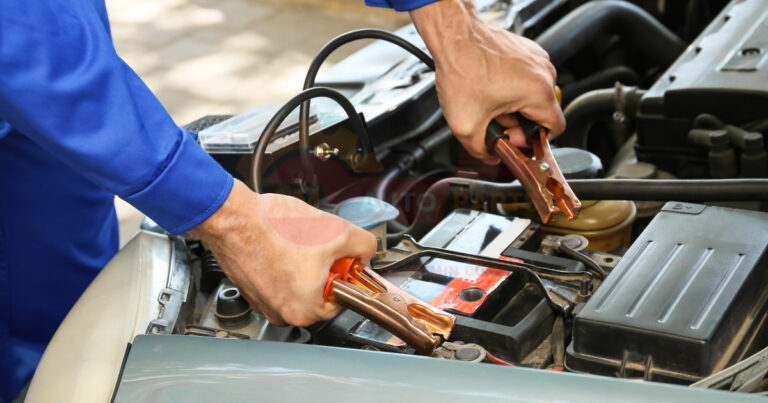How to Charge Car Batteries at Home
Car batteries are the heart of your vehicle’s electrical system, and knowing how to charge and change them at home can save you time and money. This guide will walk you through the essential steps, ensuring you can handle your car battery with confidence and safety.
Essential Steps for Charging a Car Battery at Home
Charging a car battery at home is a straightforward process if you follow the right steps. It involves selecting the appropriate charger, understanding the correct voltage, and knowing the charging time for different battery types.
Selecting the Right Battery Charger
Choosing the right battery charger is crucial for effective charging. There are various types of chargers available, including smart chargers, trickle chargers, and portable jump starters. Smart chargers are ideal for most users as they automatically adjust the charging rate and shut off when the battery is fully charged.
- Smart Chargers : Automatically adjust charging rate.
- Trickle Chargers : Provide a slow, steady charge.
- Portable Jump Starters : Useful for emergencies but not for regular charging.
Proper Voltage for Charging Car Batteries
Understanding the proper voltage is essential to avoid overcharging or undercharging your battery. Most car batteries require a charging voltage between 12.6 and 14.4 volts. Using a multimeter can help you check the battery’s current voltage and ensure it’s within the ideal range.
- Ideal Voltage Range : 12.6 to 14.4 volts.
- Use a Multimeter : To check current battery voltage.
Charging Time for Different Battery Types
The time it takes to charge a car battery depends on the type of charger and the battery’s condition. Smart chargers typically take 4-8 hours, while trickle chargers may take several days. It’s important to monitor the charging process to prevent overcharging.
- Smart Chargers : 4-8 hours.
- Trickle Chargers : Several days.
- Monitor Charging : To prevent overcharging.
What Voltage Should You Charge a Car Battery At
Charging your car battery at the correct voltage is crucial for maintaining its health and longevity. This section will guide you on the ideal voltage range and how to use a multimeter to check it.
Ideal Voltage Range for Car Battery Charging
The ideal voltage range for charging a car battery is between 12.6 and 14.4 volts. Charging within this range ensures that the battery receives enough power without the risk of overcharging, which can damage the battery.
- Safe Charging Range : 12.6 to 14.4 volts.
- Avoid Overcharging : To prevent battery damage.
Using a Multimeter to Check Battery Voltage
A multimeter is a handy tool for checking your car battery’s voltage. By connecting the multimeter to the battery terminals, you can easily determine if the battery is within the ideal voltage range. This step is crucial before and after charging.
- Connect Multimeter : To battery terminals.
- Check Voltage : Before and after charging.
Safe Methods to Change a Car Battery at Home
Changing a car battery at home can be done safely with the right tools and procedures. This section will cover the necessary tools, the step-by-step removal process, and how to install the new battery correctly.
Tools Required for Battery Replacement
Having the right tools is essential for a smooth battery replacement process. Basic tools include a wrench, gloves, and safety goggles. These tools will help you safely remove and install the battery without causing damage or injury.
- Wrench : For loosening battery terminals.
- Battery Terminal Cleaner : To remove corrosion.
Step-by-Step Battery Removal Process
Removing the old battery involves several steps. First, ensure the vehicle is turned off and the keys are removed. Then, disconnect the negative terminal followed by the positive terminal. Carefully lift the battery out of the vehicle.
- Turn Off Vehicle : Remove keys.
- Disconnect Terminals : Negative first, then positive.
- Lift Battery : Out of the vehicle carefully.
Installing the New Battery Correctly
Installing the new battery is the reverse of the removal process. Place the new battery in the tray, connect the positive terminal first, followed by the negative terminal. Ensure the battery is secure and the connections are tight.
- Place Battery : In the tray.
- Connect Terminals : Positive first, then negative.
- Secure Battery : Ensure tight connections.
Effective Ways to Charge Car Battery at Home
Charging your car battery at home can be done effectively using various methods. This section will explore using smart chargers, trickle charging, and battery maintainers for long-term storage.
Using a Smart or Automatic Charger
Smart chargers are the most efficient way to charge a car battery at home. They automatically adjust the charging rate and shut off when the battery is fully charged, preventing overcharging and extending battery life.
- Automatic Adjustment : Prevents overcharging.
- Shut Off Feature : Extends battery life.
Trickle Charging for Slow, Safe Charging
Trickle charging is a method of charging a battery slowly over an extended period. This method is ideal for maintaining a battery’s charge without the risk of overcharging, making it perfect for vehicles that are not used frequently.
- Slow Charging : Over an extended period.
- Ideal for Infrequent Use : Maintains charge safely.
Battery Maintainers for Long-Term Storage
Battery maintainers are designed to keep a battery charged over long periods without overcharging. They are perfect for vehicles in storage, ensuring the battery remains in good condition and ready for use.
- Long-Term Charging : Without overcharging.
- Perfect for Storage : Keeps battery ready for use.
Signs Your Car Battery Needs Charging or Replacement
Recognizing the signs of a weak battery can help you decide whether to recharge or replace it. This section will cover common symptoms and when to take action.
Common Symptoms of a Weak Battery
A weak battery often shows signs such as dim headlights, slow engine crank, and frequent need for jump-starts. Recognizing these symptoms early can prevent unexpected breakdowns.
- Dim Headlights : Indicate low battery power.
- Slow Engine Crank : Difficulty starting the vehicle.
- Frequent Jump-Starts : Sign of a failing battery.
When to Recharge vs. When to Replace
Deciding whether to recharge or replace a battery depends on its condition. If the battery is relatively new and shows signs of weakness, recharging may suffice. However, if the battery is old and frequently fails, replacement is recommended.
- Recharge : For newer, weak batteries.
- Replace : For old, frequently failing batteries.
Proper Maintenance to Extend Car Battery Life
Proper maintenance can significantly extend the life of your car battery. This section will cover regular voltage checks, cleaning, and avoiding deep discharges.
Regular Voltage Checks and Cleaning
Regularly checking your battery’s voltage and cleaning the terminals can prevent issues and extend battery life. Use a multimeter to check the voltage and a battery terminal cleaner to remove any corrosion.
- Voltage Checks : Prevents issues.
- Terminal Cleaning : Removes corrosion.
Avoiding Deep Discharges
Avoiding deep discharges is crucial for maintaining battery health. Deep discharges can significantly reduce a battery’s lifespan, so it’s important to keep the battery charged and avoid letting it run completely flat. Battery disconnection procedure Turn off the car and remove the key then locate the battery and carefully disconnect the negative cable first followed by the positive cable Vehicle energy repurposing is about using leftover energy from cars and trucks to power other things This helps save energy and reduces waste from vehicles
Automotive electrical measurement helps check if car parts that use electricity are working right It uses special tools to test things like batteries wires and lights in vehicles Jumpstart dead battery is a quick way to get your car running again when the battery is out of power You can use special cables to connect your car’s dead battery to another car’s working battery to bring it back to life
Electrical system weakens when too many devices are used at once This can cause power outages and make appliances work poorly Battery selection guide Choose the right battery for your device by looking at size voltage and how long it lasts
Electric vehicle safety is about making sure electric cars are safe to drive and use These cars have special features to protect people from electric shocks and battery problems Car battery charging troubles can happen when your car’s battery won’t hold a charge or takes too long to charge up
Automotive energy solutions help cars and trucks use different types of power to run These solutions include electric batteries fuel cells and cleaner fuels for vehicles
- Maintain Charge : Avoid deep discharges.
- Extend Lifespan : By keeping battery charged.
Safety Precautions When Working with Car Batteries
Working with car batteries requires certain safety precautions to prevent injury and damage. This section will cover protective gear, proper ventilation, and handling battery acid and corrosion.
Protective Gear and Proper Ventilation
Wearing protective gear such as gloves and goggles is essential when working with car batteries. Ensure the area is well-ventilated to avoid inhaling harmful fumes.
- Gloves and Goggles : For protection.
- Well-Ventilated Area : To avoid harmful fumes.
Handling Battery Acid and Corrosion
Battery acid and corrosion can be hazardous, so it’s important to handle them with care. Use a battery terminal cleaner to remove corrosion and neutralize any acid spills with baking soda.
- Battery Terminal Cleaner : Removes corrosion.
- Baking Soda : Neutralizes acid spills.
By following these guidelines, you can safely and effectively charge and change your car battery at home, ensuring your vehicle remains in top condition.
FAQ’s
How long does it take to charge a car battery at home?
Charging time varies depending on the charger type and battery condition. Smart chargers typically take 4-8 hours, while trickle chargers may take a few days. How to charge car batteries at home safely depends on using the correct charger for your battery type.
Can you charge a car battery without removing it?
Yes, you can charge a car battery without removing it from the vehicle. What to charge car battery at depends on your battery type, but most car batteries charge between 12.6 and 14.4 volts.
Is it safe to charge a car battery overnight?
Charging a car battery overnight is generally safe when using a smart charger with automatic shut-off features. How to change car battery at home safely involves disconnecting the negative terminal first and reconnecting it last.
How often should you charge your car battery?
Regular driving usually keeps a car battery charged. If the vehicle is not used frequently, charging every 4-6 weeks is recommended. How charge car battery at home effectively involves using the right charger and following proper safety procedures.






